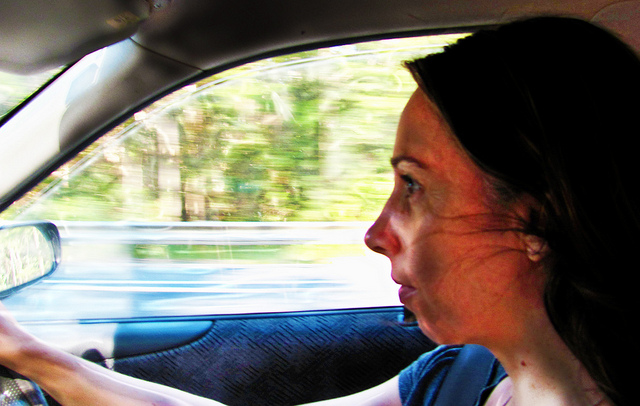On a recent trip home to see family, my parents announced they were getting rid of the car that we’d had for the past 16 years.
My parents said to me: “We know you have trouble saying goodbye to things, so we kept it around until you could make it home.”
While the lifespan of this American-made, former rental car was impressive in and of itself, it represented more than “just” the family car this time around.
It was my dad’s car. It was my first car—and it was my younger brother’s first car. And then it became my dad’s car once again.
We passed it around in circles, and used it for much longer than it was designed to be used.
But for me, it was also a relic of another time.
About four years, after I passed the car along to my younger brother, I was diagnosed with obsessive-compulsive disorder (OCD), chronic depression and binge-eating disorder.
Because of the stereotypes surrounding OCD, many of my friends and loved ones were unconvinced when I told them my diagnosis.
“You’re not cleaning or washing your hands all the time, so that can’t be true.”
As with many disorders, OCD varies widely in how it presents itself. Some people clean a lot, yes, while others have tics, and still others mostly keep their compulsions to themselves.
My particular flavor of OCD at the time of my diagnosis sampled from many of the cognitive disorders and unhealthy behaviors listed on the worksheets my therapists gave me. But one seemingly deeply ingrained component was an almost territorial style of keeping things “as they should be.”
I grew up as an Army brat, moving every few years. One of the coping mechanisms I developed in conjunction with my OCD was the need to keep what I could the same. That meant getting rid of a lot of my things with each move, but holding on tightly to a select few items.
I recall one time on vacation when I got a very simple balloon at a restaurant. Two days later, as we wrapped up the trip, my parents quite reasonably told me I couldn’t keep the balloon for the car ride home (it was likely to float perilously in the driver’s line of sight). I was devastated and cried ferociously—not because I wanted to keep my toy, but because I couldn’t imagine letting go of it.
It has been five years since I received my initial diagnosis, and I am still in therapy, nearly weekly, to untangle my thought patterns and behaviors.
Learning to let go—of control, of perfection, of being right, of material things, of the need to please, of things that no longer serve me—has been one of the most transformational experiences of my life.
By releasing myself from attachment to outcomes and things and people, I’ve freed up my brain to focus on more important things. Things like loving myself, loving others, connecting with what’s really important to me and more.
But the hardest part of learning to let go is fighting through the desire to hold on. Because those things, those memories, those experiences we’re holding onto, they serve us in some way.
Perhaps they provide comfort or a feeling of safety, yes. But perhaps they also feed our anger. Our self-victimization. Our excuses.
The stories we tell ourselves about our lives shape our experience of life.
When we’re holding on to stories about our pasts, presents or futures that seem unhealthy or not quite right, it’s because we think we need those stories to anchor us. To keep us grounded in our history of abuse, or poverty or misfortune.
Not because we want those things, but because they’re what we identify with.
However bad the stories we attach to feel, more than anything, they feel familiar.
Tap into your own stories right now. What are you telling yourself about your life that is not absolutely true?
Dig deep.
Do you feel unworthy of love? Unable to escape the expectations of your parents? Incapable of achieving wealth? Fearful of success? Shrouded in failure?
Once you identify the stories you are telling yourself that no longer serve you, release them.
You can be as ritualistic about it as you want: write it out, burn it, say “I release these stories…”—or simply reflect, and let go.
But it’s easier said than done—this will probably not be a one-time process for you.
Healing takes time. It takes space. And it takes full buy-in from you.
If you’re not committed to letting go, all the rituals and self-awareness in the world won’t do anything for you.
But once you do commit, the things you really want from your life come flooding in to fill the vacuum you made from letting the old things go.
It’s not magic—it’s not even spiritual, unless you want it to be. It’s simple psychology.
Let go of the old to invite in the new.
Back at my parent’s house, we sat around the fire pit next to the old car and shared stories about it. All the breakdowns, adventures with our (recently passed) dog, trips to the auto shop and celebrations.
My parents asked:
“Would you like to take it for one last spin while you’re here?”
I shook my head.
“I think I’m good. This has been a lovely final tribute.”
They looked at one another.
“Are you sure? You’ve always been so attached to things like this.”
I smiled.
“These days, I’m doing a lot better at letting go.”
Author: Mallie Rydzik
Image: Flickr/Celine Nadeau; Flickr/hermetic hermit
Apprentice Editor: Brandie Smith // Editor: Yoli Ramazzina







Read 0 comments and reply